Maintaining a healthy flock is crucial for successful poultry production. Internal parasites, like worms, can significantly impact bird health, productivity and profitability. All poultry reared on litter or in free-range systems are at risk of worms. Understanding the different types of worms, their lifecycles and the problems they cause is the first step towards effective management.
Understanding the Worm Life Cycle in Poultry
Poultry worms have either direct or indirect life cycles. Most poultry worms have direct life cycles, meaning they don't require an intermediate host to complete their development. The cycle begins with adult worms laying eggs within the bird's digestive tract. These eggs are then expelled into the environment via the bird's droppings. Under suitable environmental conditions, the eggs develop into infective larvae. Birds become infected by inadvertently ingesting these larvae while foraging for food, consuming contaminated water, or simply pecking at the ground. Once ingested, the larvae mature into adult worms within the bird's digestive system, starting the cycle again.
An indirect life cycle requires an intermediate host for the larval stages of the worm to develop. The adult worm lays eggs in the bird's digestive tract which are then passed in the droppings. These eggs are ingested by an intermediate host, such as an insect, snail or earthworm. Within the intermediate host, the larvae develop into a stage infective to the bird. The bird then becomes infected by consuming the infected intermediate host, and the larvae mature into adult worms within the bird, completing the life cycle.
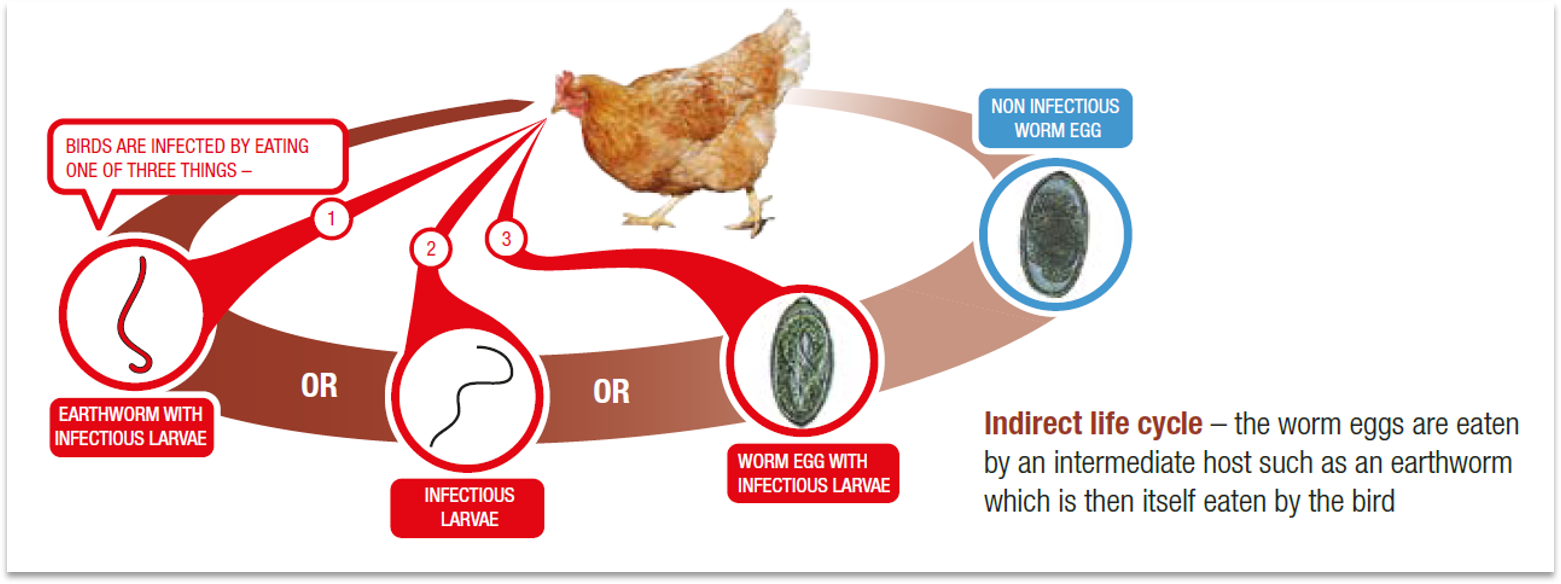
Common Types of Worms in Poultry
Several worm species can infect poultry, each with its own characteristics and potential impact. Some of the most common culprits include:
Large Roundworms (Ascaridia galli)
Roundworms are one of the most common worms in poultry. These large, white worms are typically 5 to 11cm long. They primarily reside in the small intestine, competing with the host bird for nutrients. Heavy infestations can lead to intestinal blockage, nutrient deficiencies and impaired growth.
A. galli have simple, direct life cycles. Adult female roundworms produce numerous eggs which are passed in the bird's droppings. These eggs develop in the environment and become infective within a matter of weeks. A. galli are remarkably resilient in the environment, capable of surviving for extended periods, even under harsh conditions, making them a persistent challenge for poultry producers.
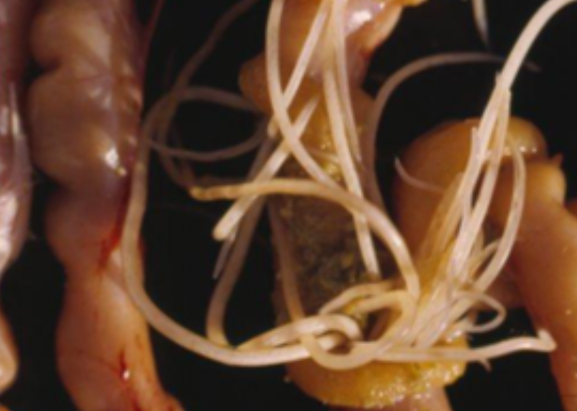
Small Roundworms/Caecal Worms (Heterakis gallinarum)
These small nematodes measure up to 1.5cm in length and inhabit the caeca, two blind connected to the intestine. Caecal worms play a critical role in the transmission of Blackhead disease. H. gallinarum acts as a vector for Histomonas melegridis, a protozoan parasite that causes Blackhead disease, primarily affecting chickens and turkeys. The caecal worm ingests the protozoan, which then develops within the worm's eggs. When a bird ingests these infected eggs, the Histomonas parasites are released, leading to Blackhead disease, which can be fatal.
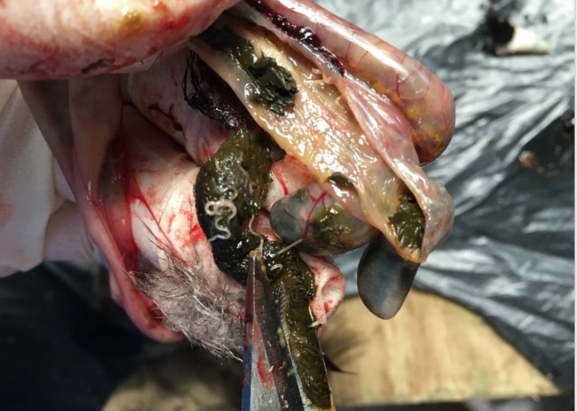
Hairworms (Capillaria spp.)
These slender, hair-like worms infest various parts of the digestive tract. Ranging from 7 to 18mm in length, these tiny worms can cause significant damage. Even in low numbers these parasites are pathogenic and produce inflammation of the intestinal lining, which can be severe, resulting in haemorrhage and death.
The life cycle of Capillaria can be direct or indirect. In the direct life cycle, infective eggs are passed in the droppings and ingested by another bird. In the direct life cycle, earthworms act as indirect hosts by ingesting the eggs. Birds then become infected by consuming the infected earthworms.
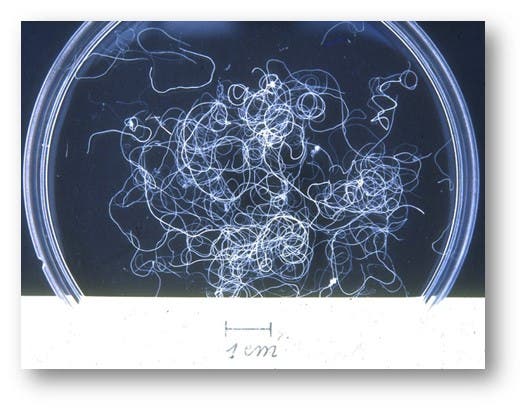
Gapeworm (Syngamus trachea)
These reddish worms are typically about 0.5 - 2cm long and are easily recognisable due to their distinctive "Y" shape, formed by the permanently attached male and female worms. They attach to the trachea, causing inflammation and obstructing airflow. This results in respiratory distress, coughing, and the characteristic "gaping" behaviour, where birds struggle to breathe with open mouths. Young birds are particularly susceptible to gapeworm infections, which can be fatal due to suffocation or secondary bacterial infections.
Gapeworms have a direct life cycle, with eggs coughed up, swallowed and then passed in the droppings. Earthworms can also act as hosts. Larvae in the eggs or free larvae are ingested by a bird or earthworm and the bird becomes infected by ingesting infected intermediate hosts or free larvae.

Large Tapeworm (Raillietina cesticillus)
Several species of tapeworm can infect poultry and grow up to 15cm long. These flat, segmented worms attach to the intestinal wall and absorb nutrients from the host.
Tapeworms have an indirect life cycle, requiring an intermediate host, usually earthworms or histerid beetles. Birds become infected by ingesting these intermediate hosts carrying tapeworm larvae. Tapeworms do not cause a large impact on production.
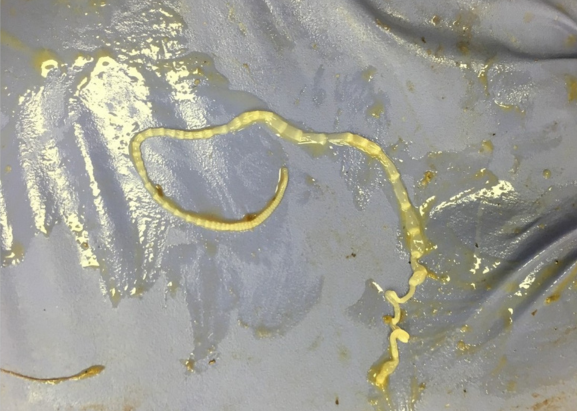
Signs of Worm Infestations in Poultry
Worm infestations in poultry can manifest in a variety of ways, often impacting bird health and productivity. The signs can be difficult to identify due to the chronic nature of the infection. Some birds show no obvious signs of illness at all.
- Diarrhoea: can range from watery to bloody
- Weight loss and poor growth: reduced nutrient absorption affects growth and overall condition
- Reduced egg production: infestations can significantly impact laying hen productivity
- Reduced egg quality: smaller eggs, pale yolks and fragile shells
- Pale combs (due to anaemia): especially with hairworms
- Respiratory distress (gapeworm): birds may gasp for air, cough and have open mouths
Diagnosing Worm Infestations
Accurate diagnosis is essential for effective worm control. Faecal floatation is a common and valuable diagnostic technique used to identify worm eggs in faecal samples collected from the flock. This method allows for a relatively simple and non-invasive assessment of the presence and type of worm infestation. Remember, birds can carry multiple worm species simultaneously.
In cases where a more definitive diagnosis is required, or when birds have succumbed to illness, a post-mortem examination can provide invaluable insights. By examining the intestines and other organs, veterinarians can directly observe adult worms and assess the extent of the infestation.
Treating Worm Infestations with FlubenolTM
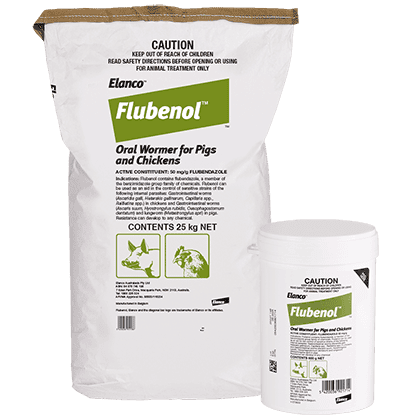
Containing the active ingredient flubendazole, Flubenol is a broad-spectrum anthelmintic with high efficacy against several species of gastrointestinal worms. Flubenol stands out for its ability to target all stages of susceptible worm life cycles, from eggs to adults. This broad-spectrum activity makes it a powerful tool for comprehensive worm control, effectively disrupting the worm's life cycle and safeguarding the health of your flock.
Prevention and Control: An Integrated Approach
Long-term success in worm control relies on integrated management strategies that combine treatment with proactive preventative measures. It is nearly impossible to completely prevent parasitic worms once a worm infestation is established, the entire environment will be heavily contaminated with infective worm eggs. Good practices can help:
- Good hygiene: regularly clean and disinfect poultry houses and equipment
- Raised feeders: feed birds from cleanable feeders rather than on the ground
- Pasture management: for outdoor poultry, rotate pastures to break the worm lifecycle by reducing the build-up of infective larvae in the environment, keep grass cover short and avoid muddy areas
- Avoid overcrowding: minimise the risk of transmission between birds
- Biosecurity: prevent the introduction of worms from external sources by quarantining new birds
- Regular worming: develop a strategic worming program in consultation with a veterinarian ensures regular treatment and minimises the development of resistance.
Always read and follow the label directions.
Flubenol™ oral wormer for pigs and chickens contains 50 mg/g flubendazole. Flubenol™, Elanco and the diagonal bar logo are trademarks of Elanco or its affiliates. ©2025 Elanco or its affiliates. EM-AU-25-0021
